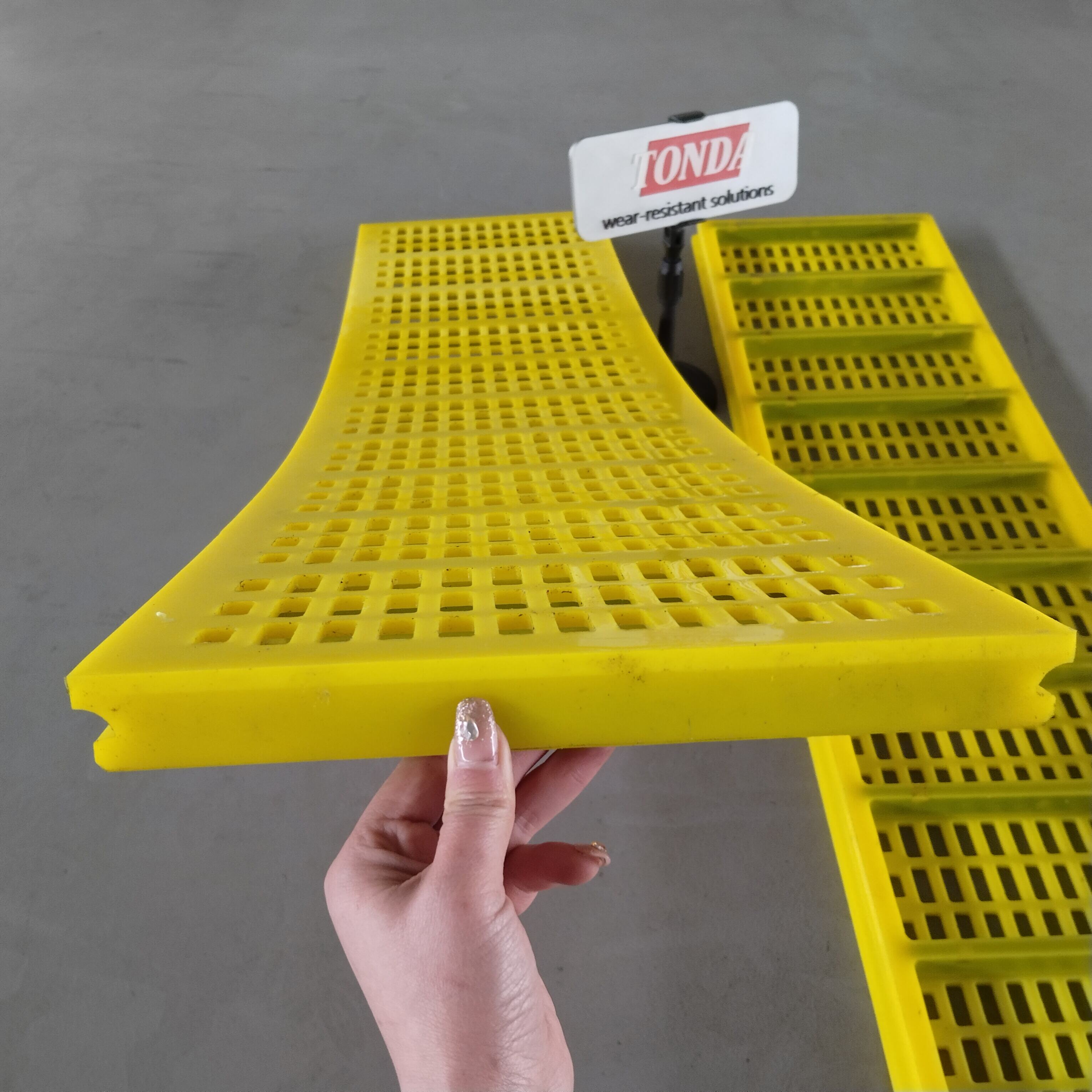How Dewatering Screens Enable Efficient Liquid-Solid Separation
The Working Principle of Dewatering Screens in Industrial Applications
These dewatering screens work by shaking materials at high frequencies while they sit on angled polyurethane surfaces. When wet material moves along the sloped surface, the fast vibrations push water through the screen mesh but keep the solid stuff behind. Getting good results depends mostly on two things: how steep the screen is angled and what size openings it has. These settings determine how long material stays on the screen before falling off, which helps avoid losing fine particles. The latest models handle around 300 tons every hour and get about 95% of the solids back when used for washing gravel or processing minerals. By changing where the dam sits at the end of the screen, operators can tweak how much time material spends there. This makes a real difference in reducing moisture content in the finished product, something we've seen firsthand at several major production facilities across different industries.
Vibrating Screen Technology and Its Role in Water Recovery
How well dewatering screens work really comes down to how intense and which way they vibrate. When these machines operate at high g-forces around 7.3 G's, they push out water much faster than standard models. The result? Solids coming off the screen typically have only about 8 to 12 percent moisture left in them. This means plants can cut back significantly on expensive thermal drying equipment and actually recycle most of their process water back into the system. Operators adjust the screen's vibration settings based on what kind of material is being processed. Fine materials need higher frequency vibrations while coarser stuff works better with lower frequencies. Most facilities report recovering somewhere between 90 and 95 percent of their process water this way, which not only saves money but also helps meet those tough environmental regulations regarding suspended solids in wastewater discharges.
Integration with Closed-Loop Systems for Continuous Water Recycling
Dewatering screens work really well when connected to closed loop systems, allowing almost all the water to be reused again and again. The water that gets captured goes back into the production process, which means companies can cut down on fresh water usage by as much as 85% for things like sand washing operations and plastic recycling plants. These systems are pretty good at catching those tiny particles too, grabbing around 98% of anything bigger than 75 microns in size before it contaminates the recycled water supply. What makes these systems so effective is their automated control system that constantly tweaks how the screens operate based on what's coming through them. Whether there's a change in how fast materials are fed into the system or differences in how dense they are, the controls keep everything running smoothly. This kind of technology supports the growing trend toward sustainability and circular economy practices across many industries today.
Optimizing Dewatering Performance Through Vibration Technology
Modern dewatering screens use advanced vibration technology to enhance liquid-solid separation and operational efficiency across diverse industrial settings.
High g-force screening for enhanced throughput and separation
When screens run at around 3 to 5g forces, they typically handle about 20 to 30 percent more material compared to standard equipment without dropping below 92 to 95 percent solids capture rates. The extra mechanical power really speeds up how fast water drains away from the material, which works particularly well when dealing with particles ranging from half a millimeter up to 10 millimeters in size. Recent tests back in 2023 found something interesting too. When these high g-force systems are paired with screens that have adjustable elasticity properties, operators saw roughly 15 percent less moisture left behind in their mineral processing operations. This kind of improvement makes a real difference in plant efficiency over time.
Tuning vibration frequency and amplitude for optimal dewatering
Optimal dewatering requires matching vibration settings to material characteristics:
- Frequency: 250–400 RPM promotes efficient particle movement
-
Amplitude: 2–6 mm balances fast drainage with effective solids retention
Proper tuning increases water removal velocity by 40% compared to fixed-vibration systems, particularly beneficial in coal and iron ore processing.
Impact of particle size and material characteristics on water transfer
Material properties significantly influence dewatering outcomes:
| Particle Size | Moisture Reduction | Ideal Vibration Profile |
|---|---|---|
| >2mm angular | 90% | High frequency (350+ RPM) |
| 0.5–2mm | 85% | Medium amplitude (4mm) |
| <0.5mm fines | 70% | Low frequency/high g-force |
| Hydrophobic materials like plastics release water 25% faster than hydrophilic ones, requiring customized screen slopes (15°–25°) for peak performance. |
Key Applications of Dewatering Screens Across Recycling Industries
Processing Recyclable Materials: Glass, Plastics, and Aggregates
Dewatering screens take out excess moisture from washed recyclables like glass cullet, plastics, and construction materials, which helps keep things pure and makes the next steps in processing go smoother. When it comes to plastic recycling specifically, these screens can get rid of about 95% of leftover water from shredded plastic bits, so they can be turned into pellets right away without extra drying. According to an industry report coming out in 2025, facilities using better configured screening systems saw their recovery rates jump by around 40% for both glass and construction aggregates. This means less stuff going to landfills and products that actually have more value on the market.
Water Reuse in Mineral Processing and Wet Screening Operations
Dewatering screens in mineral processing typically recapture around 60 to 80 percent of process water from those thick slurry streams. This helps cut down on how much fresh water needs to be brought in and supports the kind of closed loop systems that copper and iron ore plants are increasingly adopting. Pair these screens with hydrocyclones and they can get moisture content down under 15% in concentrated ores. The savings here are pretty substantial too, with thermal drying expenses dropping somewhere near $8 for every ton processed. Makes sense why this approach fits right into what regulators want to see regarding wastewater management practices across the mining sector according to recent studies looking at sustainability in mineral extraction processes.
Fine Particle Recovery and Sludge Reduction in Recycling Streams
Dewatering screens work really well at grabbing those super tiny particles smaller than half a millimeter out of recycling sludge, turning what would be waste into something useful again. Take construction sites for instance these machines can pull back around 85 to 90 percent of the fine sand mixed in with all the debris. That means about half the sludge gets removed, which obviously cuts down on how much stuff needs to be disposed of and saves money too. When it comes to processing leftovers from food production or textiles, the screens help get rid of excess moisture in things like starch or leftover fibers, bringing water content down to between 18 and 22 percent. This makes the drying process require less energy overall and helps recover more valuable materials from what might otherwise just go to waste.
Advancing Sustainability and Compliance in Industrial Water Management
Closed-Loop Water Systems and Reduced Environmental Impact
Dewatering screens play a vital role in closed loop water systems where they typically recover between 80 to 95 percent of process water right away for reuse. The impact is pretty significant actually - facilities can cut their fresh water needs by around 40% when processing minerals, plus stop sending waste water into rivers and streams. That's something the International Council on Mining and Metals has been emphasizing in their latest Water Stewardship reports from 2024 as a major sustainability indicator. Beyond just meeting environmental regulations, companies save real money too. Take one aggregate producer for instance who saw their annual water costs drop by over a million dollars after implementing these systems.
Meeting Regulatory Standards Through Efficient Solids Capture
High frequency dewatering screens manage to catch around 99 percent of particles larger than 45 microns, which helps industrial sites meet and often surpass EPA standards set by the Clean Water Act. According to recent research from last year, facilities using these advanced systems saw roughly two thirds fewer problems with compliance than older operations still dependent on conventional settling ponds. The real game changer comes with moisture sensors that monitor in real time, keeping TSS levels well within legal limits. This matters a lot for companies trying to stay compliant with GRI Water Indicators as we head into 2025 regulations. Getting those numbers right isn't just about avoiding fines anymore it's becoming part of standard operational practice across many sectors.
Fines Recovery as a Strategy for Waste Minimization and Resource Efficiency
The latest dewatering screens can actually pull out those super fine particles all the way down to 400 mesh size, stuff that normally just gets washed away in the wastewater stream. What this means for businesses is real money on the table. At many glass recycling operations, these recovered fines account for around 8 to maybe even 12 percent of what they produce overall. And while doing all that, companies are hitting those important environmental targets too. Most are now able to claim zero liquid discharge status and manage to reuse about ninety percent of their process water. This kind of performance fits right in with the circular economy ideas promoted by organizations like UNEP, but it also makes good business sense when looking at both bottom line numbers and regulatory requirements.
FAQ
What is the main function of dewatering screens in industrial applications?
Dewatering screens are primarily used to separate liquids from solids, resulting in significantly reduced moisture content in solid materials. They achieve this through high-frequency vibrations on an inclined surface, allowing water to pass through the screen mesh while retaining the solids.
How do dewatering screens contribute to water recovery and environmental compliance?
Dewatering screens help in recovering up to 95% of process water in industrial settings, which not only reduces fresh water usage by facilities but also ensures compliance with environmental regulations governing the discharge of suspended solids in wastewater.
Can dewatering screens be integrated into closed-loop systems?
Yes, dewatering screens can be effectively integrated into closed-loop systems. This integration allows for the continuous recycling of water within the production line, significantly reducing the need for fresh water and supporting sustainable practices across various industries.
What advantages do high g-force vibrating screen systems offer?
High g-force vibrating screen systems enhance throughput and improve the separation efficiency of materials. They can handle up to 30% more material without sacrificing solid capture rates, resulting in faster drainage of water and improved overall plant efficiency.

